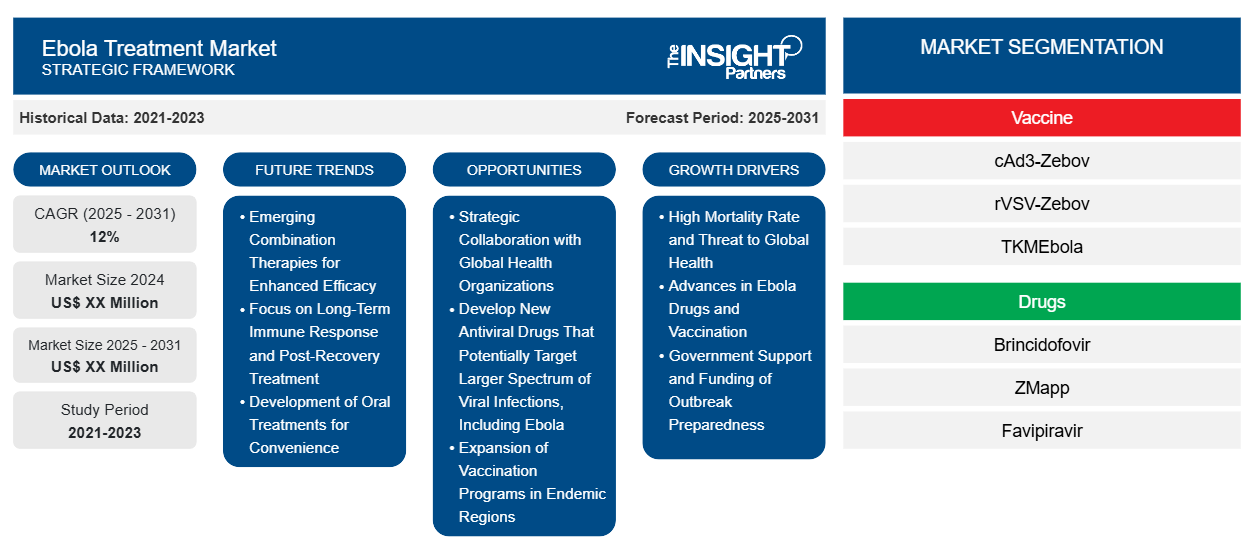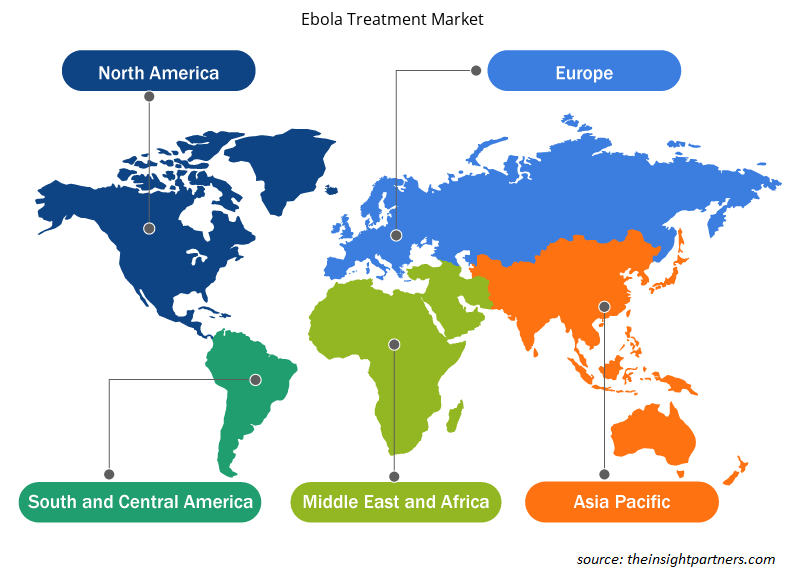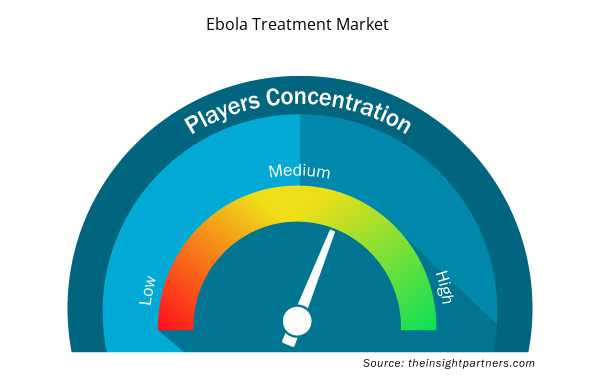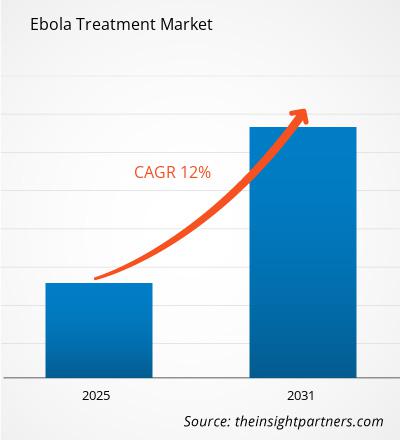The Ebola Treatment Market is expected to register a CAGR of 12% from 2025 to 2031, with a market size expanding from US$ XX Million in 2024 to US$ XX Million by 2031.
The research report on the Ebola Treatment Market is segmented by vaccines into cAd3-Zebov, rVSV-Zebov, TKMEbola, AVI-7537, HEB, BCRX, and NNVC. by drugs into Brincidofovir, ZMapp, Favipiravir, Zoloft, and Vascor. End-users include hospitals, global health organizations, pharmaceutical companies, and research institutions. The regional analysis covers key markets such as North America, Europe, Africa, Asia Pacific, and South America. The market evaluation is presented in US$ for all segmental analyses. This report explores the ongoing development of treatments for Ebola, including vaccine advancements, drug approvals, and the impact of global health initiatives on market growth.
Purpose of the Report
The report Ebola Treatment Market by The Insight Partners aims to describe the present landscape and future growth, top driving factors, challenges, and opportunities. This will provide insights to various business stakeholders, such as:
- Technology Providers/Manufacturers: To understand the evolving market dynamics and know the potential growth opportunities, enabling them to make informed strategic decisions.
- Investors: To conduct a comprehensive trend analysis regarding the market growth rate, market financial projections, and opportunities that exist across the value chain.
- Regulatory bodies: To regulate policies and police activities in the market with the aim of minimizing abuse, preserving investor trust and confidence, and upholding the integrity and stability of the market.
Ebola Treatment Market Segmentation
Vaccine
- cAd3-Zebov
- rVSV-Zebov
- TKMEbola
- AVI-7537
- HEB
- BCRX
- NNVC
Drugs
- Brincidofovir
- ZMapp
- Favipiravir
- Zoloft
- Vascor
End-user
- Hospitals
- Ambulatory Surgery Centres
- Specialized Clinics
- Army Camps
Customize This Report To Suit Your Requirement
You will get customization on any report - free of charge - including parts of this report, or country-level analysis, Excel Data pack, as well as avail great offers and discounts for start-ups & universities
Ebola Treatment Market: Strategic Insights

- Get Top Key Market Trends of this report.This FREE sample will include data analysis, ranging from market trends to estimates and forecasts.
Ebola Treatment Market Growth Drivers
- High Mortality Rate and Threat to Global Health: Ebola is one of the most lethal viral diseases ever known, with mortality levels reaching 25% to 90% for different strains and related healthcare contexts, which makes it essential to have appropriate treatments readily available, especially in outbreaks. WHO and other international health bodies have been sounding alarm bells on this issue as Ebola outbreaks tend to be true global health emergencies. Cases of West Africa and the Democratic Republic of Congo have recently shown exactly how this virus can easily spread, especially since it spreads fast through bodily fluids, and mortality rate remains alarmingly high if this virus is not treated on time. Due to the continued threat of Ebola to the global community, there is huge demand for effective treatments to prevent the spread and treat patients in case of an outbreak. The market for infectious disease therapy has grown due to these demands.
- Advances in Ebola Drugs and Vaccination: The drugs for Ebola are one of those areas that, in the past decade, has seen much advancements. As an aftermath of the 2014-2016 West African Ebola outbreak, quite a number of therapeutic options has been developed, or is awaiting development, resulting in the boost of the Ebola market. Recently, the REGN-EB3 monoclonal antibody cocktail was approved for the treatment of Ebola by FDA after demonstrating hopeful results. Furthermore, the development and successful vaccination with Ebola vaccines like Merck's rVSV-ZEBOV, which was highly efficacious in prevention of the disease, has enhanced overall management of Ebola outbreaks. Further research brings new treatments and vaccines to the market, helping advance survival rates, as well as prevent future outbreaks, and thus further fuels expansion of the market. The market is also driven by the continuous development of innovative therapies and vaccines, ensuring that healthcare systems are better equipped to respond to future outbreaks.
- Government Support and Funding of Outbreak Preparedness: The international community, comprising governments, nongovernmental organizations, and health agencies such as WHO, is now majorly interested in providing funding for the study and preparedness on outbreaks of infectious diseases including Ebola. In previous Ebola outbreaks, there were emergency funding for vaccines and treatments, and so forth. For example, the U.S. government has invested in the development of treatments through agencies like the National Institutes of Health (NIH) and the Biomedical Advanced Research and Development Authority (BARDA). These investments are crucial to ensure that Ebola treatments and vaccines are developed rapidly and available when outbreaks occur. The funding commitment for public health preparedness and support for private-sector innovation in therapeutic development provides an infrastructure to rapidly deploy effective treatments, thereby supporting market growth for Ebola-related therapeutics.
Ebola Treatment Market Future Trends
- Emerging Combination Therapies for Enhanced Efficacy: As more therapies for Ebola are developed, there is an increasing focus on combination therapies to enhance treatment efficacy. While monoclonal antibodies and antiviral drugs like remdesivir have shown promise in treating Ebola, researchers are exploring the use of combination treatments that could improve outcomes. Combining different classes of antiviral drugs or monoclonal antibodies could provide a more effective approach in targeting various stages of the Ebola virus lifecycle. For example, combining antivirals with immune-modulating therapies may not only help to reduce the viral load but also strengthen the body’s immune response to the virus. Early-stage clinical trials are exploring these combinations to see if they result in better survival rates and reduced transmission, and as data becomes available, this could become a major trend in Ebola treatment development.
- Focus on Long-Term Immune Response and Post-Recovery Treatment: One of the key future trends in the Ebola treatment market is focusing on improving long-term immunity and managing post-recovery symptoms. Survivors of Ebola often experience long-term complications, including joint pain, eye problems, and neurological issues. The development of therapeutic strategies that help manage these post-recovery conditions and boost long-term immunity is becoming increasingly important. As research continues, the focus is shifting towards enhancing the body’s immune response following infection to reduce the chance of relapse and ensure a more robust recovery process. This includes developing therapies aimed at strengthening immunity and preventing viral persistence in bodily fluids (e.g., semen), which could reduce the risk of re-transmission of the virus. The integration of treatments for post-recovery care will expand the scope of Ebola therapeutic options and support the long-term health of survivors.
- Development of Oral Treatments for Convenience:
Currently, most Ebola treatments are administered via injection or intravenous infusion, which can be logistically challenging, especially in remote areas where outbreaks occur. The development of oral antiviral medications would be a significant step forward, making treatment more accessible and easier to administer. Oral treatments for Ebola would reduce the need for hospital-based care and could be deployed more easily in emergency settings. This would also help address logistical challenges associated with transporting and administering injectable medications during outbreaks, particularly in regions with limited healthcare infrastructure. Pharmaceutical companies are increasingly investing in oral formulations of Ebola treatments to simplify administration, improve patient compliance, and make these treatments more widely available. The evolution of oral therapies could dramatically change how Ebola outbreaks are managed, contributing to improved accessibility and faster responses.
Ebola Treatment Market Opportunities
- Strategic Collaboration with Global Health Organizations: The strategic partnership with global health organizations such as the WHO, Médecins Sans Frontières (MSF), and the Global Fund provide a great platform for companies to reach more areas of the country and the globe at large to treat Ebola patients. The partners assist in disbursing drugs and vaccines across outbreak areas. Most of the areas are either far or have a low socioeconomic status, with an infrastructure not suitable for dispensing healthcare. International health organizations help in the rapid and efficient deployment of treatments in emergency situations. Moreover, funding from these organizations can drive research and development, thus accelerating the availability of new therapies. Pharmaceutical companies can, therefore, strengthen their market presence, gain access to funding, and expand their distribution capabilities in ensuring the global availability of Ebola treatments.
- Develop New Antiviral Drugs That Potentially Target Larger Spectrum of Viral Infections, Including Ebola: The discovery of antiviral drugs, which target several types of hemorrhagic fevers or emerging infectious diseases, poses a market opportunity for pharmaceutical firms. Companies developing such drugs have the potential to become leaders in the fight against a range of viral threats. The creation of broad-spectrum antiviral drugs could help manage the Ebola virus while also providing means to fight subsequent outbreaks of closely related viruses like Marburg or Lassa fever. With concerns about pandemics and emerging viral diseases growing rapidly across the world, such broad-spectrum antiviral treatment is expected to be in even greater demand. Pharmaceutical companies who invest in R&D for such drugs will end up at the leading edge of antiviral treatment, which will provide a long-term market opportunity.
- Expansion of Vaccination Programs in Endemic Regions: The opportunity to expand vaccination programs in Ebola-endemic regions presents a key opportunity for the market. Countries in West Africa, Central Africa, and parts of Asia remain at risk for Ebola outbreaks, and vaccination programs have proven to be an effective strategy for preventing further spread of the virus. Following the successful deployment of the rVSV-ZEBOV vaccine in previous outbreaks, there is potential for wider use of vaccines across at-risk populations and healthcare workers. Scaling up vaccination programs and ensuring access to vaccines in resource-limited settings presents a significant opportunity for pharmaceutical companies involved in vaccine production and distribution. Increased awareness, infrastructure development, and international cooperation will be necessary to improve vaccination coverage, making it a key market opportunity for those involved in the Ebola treatment and prevention sectors.
Ebola Treatment Market Regional Insights
The regional trends and factors influencing the Ebola Treatment Market throughout the forecast period have been thoroughly explained by the analysts at Insight Partners. This section also discusses Ebola Treatment Market segments and geography across North America, Europe, Asia Pacific, Middle East and Africa, and South and Central America.

- Get the Regional Specific Data for Ebola Treatment Market
Ebola Treatment Market Report Scope
| Report Attribute | Details |
|---|---|
| Market size in 2024 | US$ XX Million |
| Market Size by 2031 | US$ XX Million |
| Global CAGR (2025 - 2031) | 12% |
| Historical Data | 2021-2023 |
| Forecast period | 2025-2031 |
| Segments Covered |
By Vaccine
|
| Regions and Countries Covered | North America
|
| Market leaders and key company profiles |
Ebola Treatment Market Players Density: Understanding Its Impact on Business Dynamics
The Ebola Treatment Market market is growing rapidly, driven by increasing end-user demand due to factors such as evolving consumer preferences, technological advancements, and greater awareness of the product's benefits. As demand rises, businesses are expanding their offerings, innovating to meet consumer needs, and capitalizing on emerging trends, which further fuels market growth.
Market players density refers to the distribution of firms or companies operating within a particular market or industry. It indicates how many competitors (market players) are present in a given market space relative to its size or total market value.
Major Companies operating in the Ebola Treatment Market are:
- Arbutus Biopharma
- BioCryst Pharmaceuticals, Inc.
- Chimerix, Inc.
- GlaxoSmithKline
- Hemispherx Biopharma, Inc.
- Johnson & Johnson Services, Inc.
Disclaimer: The companies listed above are not ranked in any particular order.

- Get the Ebola Treatment Market top key players overview
Key Selling Points
- Comprehensive Coverage: The report comprehensively covers the analysis of products, services, types, and end users of the Ebola Treatment Market, providing a holistic landscape.
- Expert Analysis: The report is compiled based on the in-depth understanding of industry experts and analysts.
- Up-to-date Information: The report assures business relevance due to its coverage of recent information and data trends.
- Customization Options: This report can be customized to cater to specific client requirements and suit the business strategies aptly.
The research report on the Ebola Treatment Market can, therefore, help spearhead the trail of decoding and understanding the industry scenario and growth prospects. Although there can be a few valid concerns, the overall benefits of this report tend to outweigh the disadvantages.
- Historical Analysis (2 Years), Base Year, Forecast (7 Years) with CAGR
- PEST and SWOT Analysis
- Market Size Value / Volume - Global, Regional, Country
- Industry and Competitive Landscape
- Excel Dataset



Report Coverage
Revenue forecast, Company Analysis, Industry landscape, Growth factors, and Trends

Segment Covered
This text is related
to segments covered.

Regional Scope
North America, Europe, Asia Pacific, Middle East & Africa, South & Central America

Country Scope
This text is related
to country scope.
Frequently Asked Questions
The Ebola Treatment Market is expected to register a CAGR of 12% from 2025-2031.
Ebola remains a global health threat, driving advancements in drugs, vaccines, and outbreak preparedness through international funding and research efforts.
Emerging combination therapies, long-term immune response strategies, and the development of oral treatments are shaping the future of Ebola treatment, improving accessibility and patient outcomes.
Arbutus Biopharma, BioCryst Pharmaceuticals, Inc., Chimerix, Inc., GlaxoSmithKline, Hemispherx Biopharma, Inc., Johnson & Johnson Services, Inc., Mapp Biopharmaceutical, Inc., NanoViricides, Inc., NewLink Genetics Corporation
The report can be delivered in PDF/PPT format; we can also share excel dataset based on the request.
Some of the customization options available based on request are additional 3–5 company profiles and country-specific analysis of 3–5 countries of your choice. Customizations are to be requested/discussed before making final order confirmation, as our team would review the same and check the feasibility.
Trends and growth analysis reports related to Life Sciences : READ MORE..
1. Arbutus Biopharma
2. BioCryst Pharmaceuticals, Inc.
3. Chimerix, Inc.
4. GlaxoSmithKline
5. Hemispherx Biopharma, Inc.
6. Johnson & Johnson Services, Inc.
7. Mapp Biopharmaceutical, Inc.
8. NanoViricides, Inc.
9. NewLink Genetics Corporation
10. Sarepta Therapeutics

 Get Free Sample For
Get Free Sample For